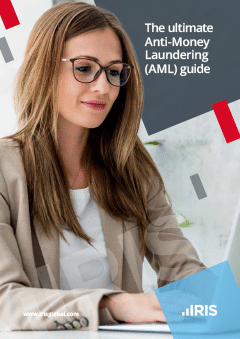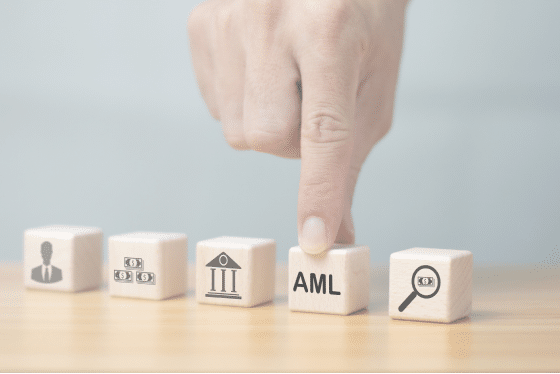What is money laundering?
Money laundering is when criminals disguise illegally obtained funds as legitimate income; typically, money laundering contains three stages, known as placement, layering, and integration.
Often, large sums of money are broken down into smaller, less suspicious amounts or cash can even be physically smuggled across borders.
Laundering money also involves putting illicit funds (e.g. smuggled cash) through complex financial transactions, such as wire transfers or buying/selling securities – this makes it difficult for law enforcement to trace where the money came from.
At this stage, the “cleaned” funds can be spent. Criminals typically use laundered money to make legal business investments, further obscuring where it came from.

What is Anti-Money Laundering?
Anti-Money Laundering (AML) measures are designed to prevent criminals from disguising illegally obtained funds as legitimate income.
AML measures help protect the financial system from criminal enterprises.
As part of AML efforts, financial professionals, like CPAs and accountants, need to know how to detect and help stop:
- Money laundering
- Tax evasion
- Fraud
- Bribery
- Corruption

Featured Guide
The ultimate guide to Anti-Money Laundering (AML)
This comprehensive free guide covers everything an accounting or CPA firm needs to know about AML.
Download now for:
- Anti-Money Laundering (AML) essentials
- Responsibilities for CPAs and accountants
- Bets practices and client red flags
- AML in other countries
- The role of AML software
Why do we need Anti-Money Laundering regulations?
According to the Organized Crime and Corruption Reporting Project, transnational illicit activities generated over $3.1 Trillion in 2023.
Anti-Money Laundering (AML) regulations ensure CPAs, accountants, and other financial professionals can do their part to curb financial crime.
With the right resources, CPAs and accountants can help prevent these funds from being illegally reintroduced into our global economy.

What do accountants and CPAs need to do for Anti-Money Laundering?
As professionals operating on the front lines of the financial system, CPAs and accountants are ideally positioned to spot and help prevent money laundering.
Because of this, accountants and CPAs have a responsibility to uphold Anti-Money Laundering (AML) practices like the ones listed here.
-
Customer due diligence (CDD)
Customer due diligence (CDD) describes the process CPA and accounting firms must go through to ensure their clients are not involved in any illegal financial activity.
As part of CDD, accountants and CPAs must:
- Confirm and authenticate their customers’ identities
- Gather data about their financial background and business dealings
- Examine their financial relationships, such as any business partnerships
While CDD is particularly crucial when firms are looking to take on a new client, ongoing customer due diligence is also required for clients who are already on the books.
Enhanced due diligence (EDD) is also required for higher-risk clients, such as customers linked to higher-risk business sectors or countries.
-
Know your customer (KYC)
Know your customer (KYC) is part of the customer due diligence (CDD) process. For KYC, accountants and CPAs need to obtain a certain level of data about a client, including verifying their identity.
KYC helps accountants to learn more about the client, including the characteristics of their trade and predicted transactions.
KYC not only helps accountants and CPAs develop a more accurate risk profile for a new client, it also helps uncover unusual or suspicious activity.
-
Transaction monitoring
To fulfil AML obligations, accountants and CPAs must scrutinize their clients’ transactions, looking out for irregular patterns or activities like:
- Unexpected, large transactions
- Swift movement of funds (especially to a non-native bank account)
- Transactions that are out of the ordinary for that client
-
Record keeping
To ensure AML measures can be carried out effectively – both by law enforcement and from within the firm itself – robust record keeping is a must.
Extensive record keeping can help facilitate:
- Ongoing transaction monitoring
- Customer due diligence (CDD) measures
- Financial or forensic audits
- Inquests or criminal investigations
-
Ongoing training
As part of your AML obligations, accounting and CPA firms are responsible for educating their team on the importance of AML and how to take appropriate action. As part of this, you’ll need to make sure suitable internal AML protocols and policies are established.
Whether a staff member has been with you for decades or they just started last week, as a firm, you must ensure they receive the training and resources necessary to fulfil AML measures. This could include:
- How to identify money laundering (e.g. Understanding CDD obligations)
- What to do and/or how to report possible money laundering
- How to use any AML or compliance-based software
-
International cooperation
Money laundering often involves international transactions – to tackle money laundering effectively, we need global collaboration.
For accountants and CPAs, this can mean sharing relevant financial information with:
- International financial organizations
- International regulatory authorities
- International law enforcement agencies
Customer due diligence (CDD)
Customer due diligence (CDD) describes the process CPA and accounting firms must go through to ensure their clients are not involved in any illegal financial activity.
As part of CDD, accountants and CPAs must:
- Confirm and authenticate their customers’ identities
- Gather data about their financial background and business dealings
- Examine their financial relationships, such as any business partnerships
While CDD is particularly crucial when firms are looking to take on a new client, ongoing customer due diligence is also required for clients who are already on the books.
Enhanced due diligence (EDD) is also required for higher-risk clients, such as customers linked to higher-risk business sectors or countries.
Frequently Asked Questions (FAQs)
Learn more about Anti-Money Laundering regulations and measures.
-
To help understand the importance of Anti-Money Laundering (AML) measures, here’s a real-world (yet fictitious) example of what money laundering might look like: in businesses like restaurants or laundromats, where cash transactions are predominant, criminals may inflate daily deposits to mix illegitimate funds with legitimate ones. A restaurant might bring in $2,000 in profits but reflect $4,000 in the books and deposit $4,000 in the bank. This mixing of legitimate and illegitimate money gets dirty funds into the financial system.
By mixing legitimate and illegal funds and putting them through a legal business, the illegal funds enter the financial system – in this case, with no one the wiser.
-
Anti-Money Laundering regulations aren’t just the responsibility of accountants and CPAs.
In the United States, AML is also the responsibility of the following financial professionals and entities:
- Banks
- Credit unions
- Brokers
- Money service businesses (MSBs)
- Realtors
- Lawyers
- Accountants
-
KYC stands for ‘know your customer’ (or know your client). It’s a crucial and mandatory process that accounting firms must go through to identify or verify the identity of a client.
Part of KYC involves investigating the validity of a client’s identity or background, such as double-checking the kind of work a business is involved in and comparing this with predicted transactions.
While KYC is an important step firms must take when bringing on a new prospective client, firms must also carry out regular KYC checks for clients already on the books.
-
Enhanced due diligence (EDD) is a type of customer due diligence (CDD), a process accounting firms use to ensure clients are not involved in illegal financial activity.
EDD relates to the checks and best practices accounting firms need to complete in situations of high risk. Examples of high-risk scenarios include, but are not restricted to:
- Instances when customers cannot be physically present
- Customers linked to higher-risk countries or business sectors
- Customers with unjustifiably complex beneficial ownership structures
- Evidence of unusual transactions (e.g. with no obvious economic or lawful purpose)
- Customers who are politically exposed persons (PEPs)
-
In North America, Anti-Money Laundering (AML) is managed and upheld by several organizations and governing bodies.
These include:
- The Bank Secrecy Act (BSA), which mandates that financial institutions support US government bodies in AML activities
- The Financial Action Task Force (FATF), which is responsible for establishing global standards to counter money laundering and terrorist financing
- The Office of Foreign Assets Control (OFAC), a division of the US Treasury Department that can apply economic sanctions to those representing a national security risk
-
The Financial Action Task Force (FATF) is an intergovernmental organization dedicated to countering money laundering and terrorist financing.
As part of a mission to establish global AML standards, the FATF has introduced 40 international Anti Money Laundering and Counter-Terrorist Financing guidelines. These standards have been embraced and implemented by over 200 nations.
-
In Mexico, the Law for the Prevention and Identification of Transactions with Illicit Funds (LFPIORPI) has been established to tackle money laundering.
As part of its ongoing mission, the LFPIORPI works to ensure financial institutions and other monitored entities fulfil AML obligations, including:
- Implementing and sustaining an AML program
- Reporting dubious transactions
- Retaining records of defined transactions.
This law also supports the seizure of assets linked to money laundering.
-
In Canada, there are several organizations and entities responsible for AML and its enforcement.
- The Proceeds of Crime (Money Laundering) and Terrorist Financing Act (PCMLTFA) – the principal law that oversees AML and mandates compliance in Canada
- Financial Transactions and Reports Analysis Centre of Canada (FINTRAC) – the body entrusted with the implementation and enforcement of the PCMLTFA
- Canadian Anti-Fraud Centre (CAFC) – home of the national anti-fraud hotline, the CAFC also helps investigate money laundering and prosecute perpetrators
- Office of the Superintendent of Financial Institutions (OSFI) – Canada’s main overseer of federally regulated financial institutions (e.g. banks)
-
In the UK, there are a few key legal frameworks that help uphold AML.
- The Proceeds of Crime Act (POCA) – the foundation of the UK’s Anti-Money Laundering structure, POCA aims to prevent money laundering and the proliferation of illegal funds
- The Money Laundering Regulations 2017 – fortifies oversight within the private sector, ensuring enterprises establish a written AML risk assessment
- The Money Laundering Regulations 2019 – a legal framework which strengthened the UK’s AML approach (e.g. improving customer due diligence processes)
More content

Blog Article
FASB ASC 842 Accounting Standards Updates

Blog Article
ASC 842: What, Why, When & How?

Blog Article

